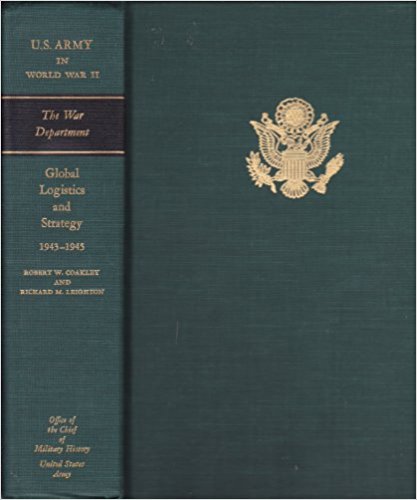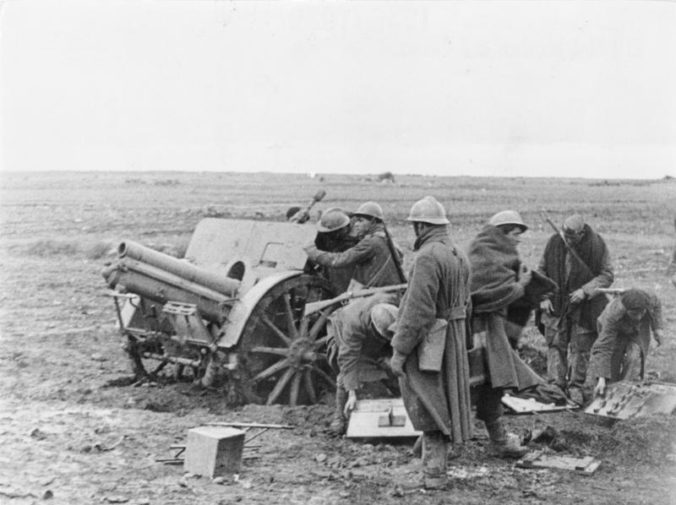The number of studies and books published by the US military on the Second World War alone fills a small library. Official histories do not only exist for the Army and the Navy, then the two arms of the US military, but also for the nascent forces of the Air Force and the Marines, and of course for countless other organisations like the Corps of Engineers or the Coast Guard. For brevitys sake, we will limit this bibliography to the classic trio of Army, Navy and Air Force. For further research have a look at hyperwar, the not always up-to-date, but always useful collection of links about military history.
The US Army in World War II
Better known as “The Green Books,” The U.S. Army in World War II consists of 79 volumes plus a reader’s guide. Unlike the official histories of some countries, these volumes were often written by professional historians, such as Robert R. Palmer, Forrest Pogue, or Bell I. Wiley, rather than staff officers.
As with official histories, every campaign is covered in great detail, often starting with descriptions from the front lines rather than with strategic plannings and the big picture. But the really valuable volumes are the ones dealing with what usually only gets experts exited. That is to say, the volumes on to/e, logistics, medical service, and more. The detail in these is often extraordinary, as they delve into matters that, although largely invisible in most histories, were essential to shaping an army that could fight and win.
The US Army in WW 2 – Reader’s Guide
The War Department
Chief of Staff- Prewar Plans and Preparations, Mark Skinner Watson
Washington Command Post – The Operations Division. Ray S. Cline
Strategic Planning for Coalition Warfare – 1941-1942, Maurice Matloff and Edwin M. Snell
Strategic Planning for Coalition Warfare – 1943-1944. Maurice Matloff
Global Logistics and Strategy 1940 – 1943, Richard M. Leighton
Global Logistics and Strategy 1943 – 1945, Robert W. Coakley and Richard M. Leighton
The Army and Economic Mobilization, R. Elberton Smith
The Army and Industrial Manpower, Byron Fairchild and Jonathan Grossman
The Army Ground Forces
The Organization of Ground Combat Troops, Ken Roberts Greenfield, Robert R. Palmer and Bell I. Wiley
The Procurement and Training of Ground Combat Troops, Robert R. Palmer, Bell I. Wiley and William R. Keast
The Army Service Forces
The Organization and Role of the Army Service Forces, John D. Millett
The Western Hemisphere
The Framework of Hemisphere Defense, Stetson Conn and Byron Fairchild
Guarding the United States and Its Outposts. Stetson Conn. Rose C. Engelman and Byron Fairchild
The War in the Pacific
Strategy and Command- The First Two Years, Louis Morton
The Fall of the Philippines, Louis Morton
Guadalcanal- The First Offensive, John Miller, jr.
Cartwheel – The Reduction of Rabaul, John Miller, jr.
Seizure of the Gilberts and Marshalls, Philip A. Crowl and Edmund G. Love
Campaign in the Marianas, Philip A. Crowl
The Approach to the Philippines, Robert Ross Smith
Leyte: The Return to the Phillippines, M. Hamlin Cannon
Triumph in the Philippines, Robert Ross Smith
Okinawa: The Last Battle, Roy E. Appleman, James M. Burns, Russell A. Gugeler, John Stevens
The Mediterranean Theater of Operations
Sicily and the Surrender of Italy, LTC Albert N. Garland and Howard McGaw Smyth. Assisted by Martin Blumenson
Northwest Africa: Seizing the Initiative in the West, George F. Howe
Salerno to Cassino, Martin Blumenson
Cassino to the Alps, Ernest F. Fisher, Jr.
The European Theater of Operations
The Supreme Command, Forest C. Pogue
Logistical Support of the Armies, Vol I, May 1941 – September 1941, Roland G. Ruppenthal
Logistical Support of the Armies, Vol. 2, Roland G. Ruppenthal
Cross Channel Attack, Gordon A. Harrison
Breakout and Pursuit, Martin Blumenson
The Lorraine Campaign, Hugh M. Cole
The Siegfried Line Campaign, Charles B. MacDonald
The Ardennes – Battle of the Bulge, Hugh M. Cole
The Last Offensive, Charles B. MacDonald
Riviera to the Rhine, Jeffrey J. Clarke, Robert Ross Smith
The Middle East Theater
The China-Burma-India Theater
Special Studies
Pictorial Record
The US Navy in World War II
Immediately after the attack on Pearl Harbor, Morison, already convinced of the value of personal involvement as a result of sailing experience while writing his biography of Christopher Columbus, wrote to President Roosevelt suggesting the preparation of an official history of the Navy in the war, and volunteering for the task. Both President Roosevelt and the Secretary of the Navy Frank Knox agreed, and in May 1942 Morison was commissioned as a Lieutenant Commander in the United States Naval Reserve, and assigned a staff of assistants, with permission to go anywhere and to see all official records. Morison’s reputation as a knowledgeable sailor (based on his analysis in the biography of Christopher Columbus) preceded him, and he was welcomed on a number of ships, eleven of them in all by the end of the war.
The result was a normal historical work, not a prescribed official history. Limitations of the History of U.S. Naval Operations are mostly due to its shortened period of publication. Some material, especially related to codebreaking, was still classified, and later in-depth research into particular occurrences in the war did clarify points that had been passed over rather lightly. Some rewriting was incorporated in the later printings of this series. This History of U.S. Naval Operations also intentionally avoided a certain amount of analysis, for instance deferring to other works for the causes of the Japanese Attack on Pearl Harbor. The intended audience for the work, to quote from the preface, was “the general reader rather than the professional sailor.”
The books can be downloaded free of charge for 14 days at archive.org.
Vol. I: The Battle of the Atlantic, September 1939–May 1943
Vol. II: Operations in North African Waters, October 1942–June 1943
Vol. III: The Rising Sun in the Pacific, 1931–April 1942
Vol. IV: Coral Sea, Midway and Submarine Actions, May–August, 1942
Vol. V: The Struggle for Guadalcanal, August 1942–February 1943
Vol. VI: Breaking the Bismarcks Barrier, 22 July 1942–1 May 1944
Vol. VII: Aleutians, Gilberts and Marshalls, June 1942–April 1944
Vol. VIII: New Guinea and the Marianas, 1944
Vol. IX: Sicily, Salerno and Anzio, 1943–1944
Vol. X: The Battle of the Atlantic Won, May 1943–May 1945
Vol. XI: The Invasion of France and Germany, 1944–1945
Vol. XII: Leyte, June 1944–January 1945
Vol. XIII: The Liberation of the Philippines, 1944–1945
Vol. XIV: Victory in the Pacific
Vol. XV: Supplement and General Index
The US Airforce in World War II
The US Airforce became an independent combat arm in 1947. Prior to 1947, the responsibility for military aviation was divided between the Army (for land-based operations) and the Navy, and Marine Corps, for sea-based operations from aircraft carrier and amphibious aircraft.
In March 1942, President Franklin D. Roosevelt wrote to the Director of the Bureau of the Budget ordering each war agency to prepare “an accurate and objective account”of that agency’s war experience. Soon after, the Army Air Forces began hiring professional historians so that its history could be recorded. An Historical Division was established in Headquarters Army Air Forces under Air Intelligence, in September 1942, and the modern Air Force historical program began. With the end of the war, Headquarters approved a plan for writing and publishing a seven-volume history. In December 1945, Lieutenant General Ira C. Eaker, Deputy Commander of Army Air Forces, asked the Chancellor of the University of Chicago to assume the responsibility for the publication of the history. Lieutenant Colonel Wesley Frank Craven of New York University and Major James Lea Cate of the University of Chicago, both of whom had been assigned to the historical program, were selected to be editors of the volumes. Between 1948 and 1958 seven were published.
Volume One: Plans and Early Operations January 1939 to August 1942
Volume Two: Europe: Torch to Pointblank August 1942 to December 1943
Volume Three: Europe: Argument to V-E Day January 1944 to May 1945
Volume Four: The Pacific: Guadalcanal to Saipan August 1942 to July 1944
Volume Five: The Pacific: Matterhorn to Nagasaki June 1944 to August 1945
Volume Six: Men and Planes
Volume Seven: Services Around the World
Further Reading:
United States Army Air Force (“Craven and Cate”)
http://www.afhso.af.mil/booksandpublications/conflictindex.asp


